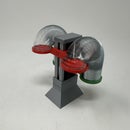Introduction: Marblevator, Line Follower.
In "Marblevator, Line Follower" a simple ball bearing follows an irregular shaped black line much like the many elaborate robotic line followers.
This seemingly impossible feat (the electronics in the ball bearing would have to be quite small!) is accomplished using simple magnetics, a hidden track, a motor and a battery. A magnetic sphere is rotated around the hidden irregular shaped track inside a hollow arm that is rotated by the motor. The black line is located in the center of the hidden track. A ball bearing on the top of the track follows the hidden magnetic sphere which is following the hidden track, giving the appearance that the ball bearing is following the black line.
To avoid having to disassemble the model in order to charge the battery, I've included an optional base and inductive charger. Simply set the "Marblevator, Line Follower" on the base to charge it!
As usual, I probably forgot a file or two or who knows what else, so if you have any questions, please do not hesitate to ask as I do make plenty of mistakes.
Designed using Autodesk Fusion 360, sliced using Ultimaker Cura 4.12.1, and 3D printed in PLA and Tough PLA on Ultimaker S5s.
Supplies
- Soldering iron and solder.
- Thick double sided tape.
- Thick cyanoacrylate glue.
Step 1: Parts.
I acquired the following parts:
- One uxcell SS12d00g3 mini slide switch.
- One 6VDC 30RPM gear motor.
- One 3.7vdc 160MA LiPo battery with PH2.0mm JST connector.
- One TP4056 Type-C USB 5V 1A battery charger module.
- One 9.5mm diameter magnetic sphere.
- One 9.5mm ball bearing.
- Two female JST connectors compatible with the battery connector.
- One male JST connector compatible with the battery connector.
- One 12vdc 1A power supply.
- One 5vdc 500mA inductive charging set (Adafruit PID: 1407)
I 3D printed the following parts at .15mm layer height, 20% infill and no supports in PLA unless noted otherwise:
- One "Arm.stl".
- One "Base.stl" (Tough PLA).
- Four "Bolt (M8 by 8mm).stl".
- One "Cover, Base.stl" (Tough PLA).
- One "Cover.stl".
- One "Electronics Tray.stl" (Tough PLA).
- One "Mount, Motor.stl".
- Four "Standoff (M8 by 8mm).stl".
- One "Track.3mf" (dual extrusion).
This is a high precision 3D print and assembly model using at times very small precision 3D printed parts in very tight spaces. Prior to assembly, test fit and trim, file, sand, polish, etc. all parts as necessary for smooth movement of moving surfaces, and tight fit for non moving surfaces. Depending on you printer, your printer settings and the colors you chose, more or less trimming, filing, sanding and/or polishing may be required. Carefully file all edges that contacted the build plate to make absolutely certain that all build plate "ooze" is removed and that all edges are smooth. I used small jewelers files and plenty of patience to perform this step.
The model also uses threaded assembly thus an M8 by 1.25 tap and die will assist with thread cleaning if necessary.
Step 2: Base Assembly.
To assemble the base, I performed the following steps:
- Removed the red and black wires from the inductive transmitter circuit board.
- Glued the inductive transmitter coil in "Base.stl".
- Slid the 12vdc power supply wires through the hole in the base.
- Soldered the 12vdc power supply wires to the inductive transmitter circuit board making certain to match the polarity.
- Secured the inductive transmitter circuit board to the base using double sided tape.
- Pressed "Cover, Base.stl" onto the base.
Step 3: Electronics Tray Assembly.
To assemble the electronics tray, I performed the following steps:
- Glued the inductive receiver coil onto "Electronics Tray.stl".
- Attached the inductive receiver circuit board the the tray using double sided tape.
- Soldered the inductive receiver circuit board "+" (red) wire to the battery charger module "+".
- Soldered the inductive receiver circuit board "-" (black) wire to the battery charger module "-".
- Soldered a female JST connector to the battery charger module , red to "B+" and black to "B-".
- Soldered a female JST connector to the battery charger module, red to "OUT+" and black to "OUT-".
- Attached the battery charger module to the tray using double sided tape.
- Attached the LiPo battery to the tray using double sided tape.
- Pressed the slide switch into the tray.
Step 4: Motor Mount Assembly.
To assemble the motor mount, I performed the following steps:
- Soldered a male JST connector red wire to the motor "+" terminal and black wire to the motor "-" terminal, then cut the black wire in half.
- Soldered the black JST connector wire to the slide switch center terminal.
- Soldered the black motor "-" wire to the switch outer terminal.
- Slid the switch to the off position.
- Pressed the gear motor into "Mount, Motor.stl".
- Pressed "Arm.stl" onto the gear motor shaft.
Step 5: Final Assembly.
For final assembly, I performed the following steps:
- Secured the motor mount assembly to "Track.3mf" using four "Standoff (M8 by 8mm).stl".
- Plugged the motor male JST connector into the female JST battery charger module "OUT" connector.
- Plugged the battery male JST connector into the female JST battery charger module "B" female connector.
- Adjusted the motor position to insure the arm is centered between the track and the motor mount assembly.
- Slid the magnetic sphere into the arm then placed the ball bearing on the track over the magnetic sphere.
- Positioned the electronics tray and "Cover.stl" over the four standoffs and secured them in place using four "Bolt (M8 by 8mm).stl".
With final assembly complete I turned on the switch and off it went!
And that is how I 3D printed and assembled "Marblevator, Line Follower".
I hope you enjoyed it!

Second Prize in the
Magnets Contest





















